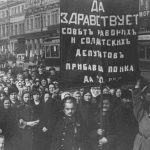 Louis (1754 – 1793) was the last (Capet) King of France. He reigned, not well but to the best of his limited capabilities, from 1774 – 92. He joins the list of European monarchs judicially murdered by his own countrymen for political reasons: he was married to an Austrian, Marie-Antoinette. Others on the list are Alexander II and Nicholas II of Russia, Charles I of England and Haile Selassie of Ethiopia.
Louis (1754 – 1793) was the last (Capet) King of France. He reigned, not well but to the best of his limited capabilities, from 1774 – 92. He joins the list of European monarchs judicially murdered by his own countrymen for political reasons: he was married to an Austrian, Marie-Antoinette. Others on the list are Alexander II and Nicholas II of Russia, Charles I of England and Haile Selassie of Ethiopia.
Most historians of the eighteenth century agree that Louis, who ascended the throne of France at only twenty, was a weak character, vacillating and easily persuaded. Sadly, he shared the same characteristics as Charles I of England, in that both thought they were king because of divine right and the blood of their ancestors, and were quite blind to the stirrings of anti-monarchical revolution.
Louis married an Austrian girl of firm will and good intentions, Marie Antoinette, though this name was adopted in order to sound more French. He immediately came under the influence of his infinitely stronger wife, and that influence was not always for the good of France. For instance he could neither avoid the imminent revolution by backing the economic and social reforms proposed among others by the faithful Necker; nor could he become a popular monarch, loved by his people, because he hardly knew of their existence, such was his upbringing. He did know however that ‘out there beyond the palace gates’, was a seething mass of millions of French people who were supposed to worship and obey him because he was King. Such a man was bound to come to a bad end.
He assembled the Assembly of Notables (almost entirely aristocratic) in 1787, which managed to achieve nothing at all, and then the more democratic but creaking States-General, which had not been called for nearly two hundred years. Thus the French Revolution (qv.) started.
Louis, Marie Antoinette and the children were forced to move from the Palace of Versailles to Paris in October 1789. But they tried to flee the country, being stopped and arrested at Varennes (1791). After this the Jacobins, now compoletely in the saddle, kept the royal family prisoner until they had abolished the monarchy (September 1792). Under the name of Louis Capet the king was subjected to a trial before the Committee ‘under Robespierre’, found guilty of treason, and went to the guillotine in January, 1793. His wife followed him to the knife only six months later.
Marie Antoinette: This Queen of France (pictured first with her husband Louis) was actually Austrian, daughter of Maria Theresa and Francis I. She was barely fourteen years old when the arranged marriage with the Dauphin of France took place. Briefly, she was popular with the crowd, until tales of her extravagance were circulated by the middle-class dissident revolutionaries. The latter did not like a present given her by the King – a delightful mini-palace called Le Petit Trianon – not much more than a large hunting lodge, situated near Versailles. Here Marie would entertain the Court and her husband with masked balls and other follies, leading to her gaining a reputation as a brainless flippertygibbit – and foreign to make it worse.
Throughout the opening months of the French Revolution, however, Marie showed remarkable bravery, tenacity and dignity. That at least the historians recognise. Legends about her grew: for example, she did not say ‘Let them eat cake’ when famished crowds knocked down the gates at Versailles. She asked if there were any bread, and on being told there was not, she ordered all the available cake in the kitchens to be given to the people. This is quite a different story to the popular (and incorrect) socialist one.
It was useless to defend her, and the King was a lost chord. She was unpopular because she was foreign, pretty, well-fed, and royal. Rather sadly, she became involved in an attempted rescue bid by her Austrian family, and the Committee of Public Safety lopped off her pretty head in the guillotine (1793).








Leave A Comment